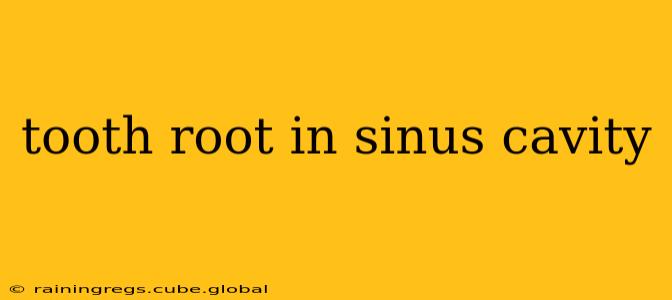A tooth root in the sinus cavity, also known as an oroantral fistula or sinus perforation, is a more serious dental complication that requires immediate professional attention. This condition occurs when the root of a tooth, or a portion of it, penetrates the thin bone separating the upper teeth from the maxillary sinus (a cavity located behind your cheekbones). This can lead to significant discomfort, infection, and other health problems if left untreated. This comprehensive guide explores the causes, symptoms, and treatment options for this dental issue.
What Causes a Tooth Root in the Sinus Cavity?
Several factors can contribute to a tooth root ending up in the sinus cavity. The most common cause is the extraction of an upper molar tooth. During extraction, particularly if the tooth is impacted or has extensive decay, the thin bone separating the tooth socket from the sinus cavity can be perforated. This leaves a pathway for the root to enter the sinus.
Other causes include:
- Infections: Severe infections around the root of a tooth (periapical abscess) can erode the bone, creating a pathway into the sinus.
- Trauma: Facial trauma or injuries to the upper jaw can fracture the bone and potentially displace tooth roots into the sinus.
- Cysts: Dental cysts, which are fluid-filled sacs that form around the roots of teeth, can grow large enough to erode the bone and extend into the sinus.
- Sinusitis: Although less common, chronic sinusitis can sometimes create pathways for tooth roots to migrate into the sinus cavity.
What are the Symptoms of a Tooth Root in the Sinus Cavity?
Symptoms can vary depending on the severity and presence of infection. Some individuals may experience no symptoms at all, particularly if the root fragment is small and doesn't cause any irritation or inflammation. However, common symptoms include:
- Pain and Swelling: Pain in the upper jaw and cheek area is a frequent symptom, often accompanied by swelling.
- Sinus Infection: A tooth root in the sinus can cause or worsen a sinus infection, leading to nasal congestion, post-nasal drip, and facial pressure.
- Drainage: Pus or other drainage may be noticeable in the nasal passages.
- Bad Breath: The presence of a foreign body in the sinus can contribute to bad breath (halitosis).
- Numbness or Tingling: In some cases, numbness or tingling may be felt in the upper teeth or lip.
How is a Tooth Root in the Sinus Cavity Diagnosed?
Diagnosis typically involves a combination of techniques:
- Clinical Examination: Your dentist will conduct a thorough oral examination, checking for any abnormalities or signs of infection.
- Dental X-rays: X-rays of the affected area provide visual confirmation of the tooth root's location and any associated bone loss. Panoramic X-rays or Cone Beam Computed Tomography (CBCT) scans offer a more detailed view.
- Sinus X-rays: In some cases, X-rays specifically focusing on the sinus cavity may be necessary to assess the extent of the involvement.
What is the Treatment for a Tooth Root in the Sinus Cavity?
Treatment depends on several factors, including the size of the root fragment, the presence of infection, and the overall health of the patient. Common treatment options include:
- Surgical Removal: This is the most common treatment and often involves a surgical procedure to access and remove the tooth root fragment from the sinus. This may require a collaboration between an oral surgeon and an ENT specialist (ear, nose, and throat doctor).
- Antibiotics: If an infection is present, antibiotics are prescribed to clear the infection before or after surgery.
- Sinus Rinse: Saline sinus rinses can help to clear out any debris or inflammation in the sinus cavity.
What Happens if a Tooth Root in the Sinus Cavity is Left Untreated?
Leaving a tooth root in the sinus cavity untreated can lead to several complications:
- Persistent Infection: A chronic sinus infection can develop, leading to ongoing pain, inflammation, and potentially more serious health problems.
- Sinusitis: Chronic sinusitis can result, requiring prolonged antibiotic treatment or even surgical intervention.
- Formation of Granulomas: A granuloma (a small mass of tissue) may form around the tooth root, potentially causing further complications.
Can a Tooth Root in the Sinus Cavity Heal on Its Own?
Generally, a tooth root in the sinus cavity will not heal on its own. The foreign body in the sinus cavity will likely cause ongoing inflammation and infection. Professional medical intervention is crucial for proper healing and to prevent serious complications.
How Can I Prevent a Tooth Root from Entering My Sinus Cavity?
While not always preventable, the risk can be reduced by:
- Careful Dental Extractions: Choose a skilled and experienced dentist or oral surgeon for tooth extractions, especially upper molars.
- Proper Dental Hygiene: Maintaining good oral hygiene practices helps prevent infections that could weaken the bone and increase the risk of complications.
This information is for educational purposes only and does not constitute medical advice. Always consult with a qualified dental professional for diagnosis and treatment of any dental issues.
